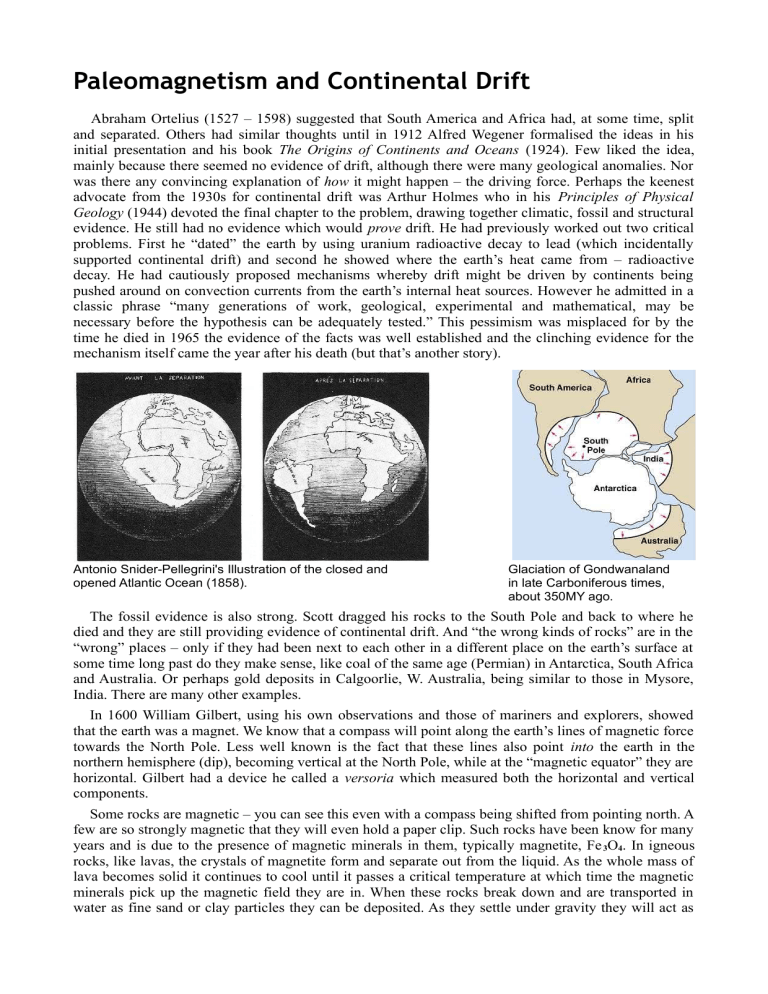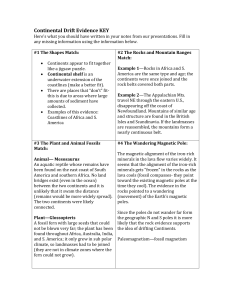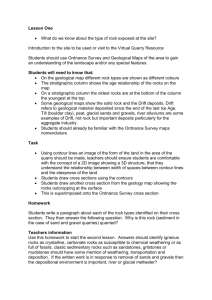Paleomagnetism and Continental Drift

Paleomagnetism and Continental Drift
Abraham Ortelius (1527 – 1598) suggested that South America and Africa had, at some time, split and separated. Others had similar thoughts until in 1912 Alfred Wegener formalised the ideas in his initial presentation and his book The Origins of Continents and Oceans (1924). Few liked the idea, mainly because there seemed no evidence of drift, although there were many geological anomalies. Nor was there any convincing explanation of how it might happen – the driving force. Perhaps the keenest advocate from the 1930s for continental drift was Arthur Holmes who in his Principles of Physical
Geology (1944) devoted the final chapter to the problem, drawing together climatic, fossil and structural evidence. He still had no evidence which would prove drift. He had previously worked out two critical problems. First he “dated” the earth by using uranium radioactive decay to lead (which incidentally supported continental drift) and second he showed where the earth’s heat came from – radioactive decay. He had cautiously proposed mechanisms whereby drift might be driven by continents being pushed around on convection currents from the earth’s internal heat sources. However he admitted in a classic phrase “many generations of work, geological, experimental and mathematical, may be necessary before the hypothesis can be adequately tested.” This pessimism was misplaced for by the time he died in 1965 the evidence of the facts was well established and the clinching evidence for the mechanism itself came the year after his death (but that’s another story).
Antonio Snider-Pellegrini's Illustration of the closed and opened Atlantic Ocean (1858).
Glaciation of Gondwanaland
in late Carboniferous times,
about 350MY ago.
The fossil evidence is also strong. Scott dragged his rocks to the South Pole and back to where he died and they are still providing evidence of continental drift. And “the wrong kinds of rocks” are in the
“wrong” places – only if they had been next to each other in a different place on the earth’s surface at some time long past do they make sense, like coal of the same age (Permian) in Antarctica, South Africa and Australia. Or perhaps gold deposits in Calgoorlie, W. Australia, being similar to those in Mysore,
India. There are many other examples.
In 1600 William Gilbert, using his own observations and those of mariners and explorers, showed that the earth was a magnet. We know that a compass will point along the earth’s lines of magnetic force towards the North Pole. Less well known is the fact that these lines also point into the earth in the northern hemisphere (dip), becoming vertical at the North Pole, while at the “magnetic equator” they are horizontal. Gilbert had a device he called a versoria which measured both the horizontal and vertical components.
Some rocks are magnetic – you can see this even with a compass being shifted from pointing north. A few are so strongly magnetic that they will even hold a paper clip. Such rocks have been know for many years and is due to the presence of magnetic minerals in them, typically magnetite, Fe
3
O
4
. In igneous rocks, like lavas, the crystals of magnetite form and separate out from the liquid. As the whole mass of lava becomes solid it continues to cool until it passes a critical temperature at which time the magnetic minerals pick up the magnetic field they are in. When these rocks break down and are transported in water as fine sand or clay particles they can be deposited. As they settle under gravity they will act as
little compass needles and once again align themselves with whatever the earth’s magnetic field may be.
This alignment in both igneous and sedimentary rocks reflects not only the north-south direction of the magnetic field where the rock forms but also its dip.
In the mid 1950s Keith Runcorn and his group at Newcastle devised a sensitive magnetometer by which they could measure the magnetic direction in not just strongly magnetised igneous rocks but in weaker sedimentary rocks like sandstones and shales. If a magnet or some magnetic rock is brought up below the lower magnet a small deflection occurs, counteracted by the twist in the phosphor bronze ribbon. This deflection is measured using light on the mirror and after a few measurements and routine sums the direction of the magnetism in the rock specimen can be calculated.
More calculations using this direction, expressed both as the ancient N-S and dip, will show where the magnetic pole was on the earth’s surface when the rock was formed. The when Holmes, remember, has already calculated.
Repeating this on many rocks of different ages from locations all over the world began to produce a confusing picture. With just a few results (right) from Europe (red) and
North America (blue) thoughts were, in the 1950s, still of a
“wandering pole”, similar to ideas of the 1930s. But soon the only real answer was to move the continents and not the pole so that the magnetic directions for the relocated continents gave coincident North poles for the same ages.
Using this approach the path of each continent at different dates could be plotted and at last continental drift made sense. It was not long before the earlier evidence from fossils, rock types, climate effects began to coincide with the datable magnetic data.
This was what Holmes had thought would take generations to accomplish. It had been done within just a few decades of his own work, initially and coincidentally much of it at his own University of Durham. So from the
From Creer, Irving & Runcorn,
Phil. Trans. Roy. Soc. 1957 initial work in the 1950s we have added to the descriptive evidence (climate, fossil, structural) in a timeframe of geological periods for continental drift much physical evidence accurately dated in millions of years – just what Holmes wanted in 1944. Paleomagnetism is now such a powerful tool that it is used where Holmes could never have imagined.
As might be imagined the simple explanations, above, of how rocks acquire their magnetism (if they do) and how this is measured using the astatic magnetometer even in the magnetically “quiet” surroundings of a non-magnetic hut in the country are, indeed, much too simple. While the first tentative steps were being made to show that continents did move the first attempts were being made to remove the “noise” of magnetic effects often acquired by rocks in the millions of years since their formation and initial magnetisation. These methods are generally based on partial demagnetisation using gentle heating or increasing alternating magnetic fields. Few investigations these days go ahead without some form or some degree of this “magnetic cleaning.”
At the same time more sensitivity and faster methods of measurement were being developed. These started with spinning magnetometers in which the sample of rock was spun at high speed in a coil. The magnetism in the rotating rock and the coil acted as a dynamo and, with the usual sleight of hand, the strength and direction of the rock’s field could be calculated and then the corresponding position of the pole or, more correctly, the more likely location of the rock at the time of its formation. Later, but not much, came SQUID or S emiconducting QU antum I nterference D evice (and don’t even ask!) which is highly sensitive and extremely rapid.
P. Dewell. April 2014





